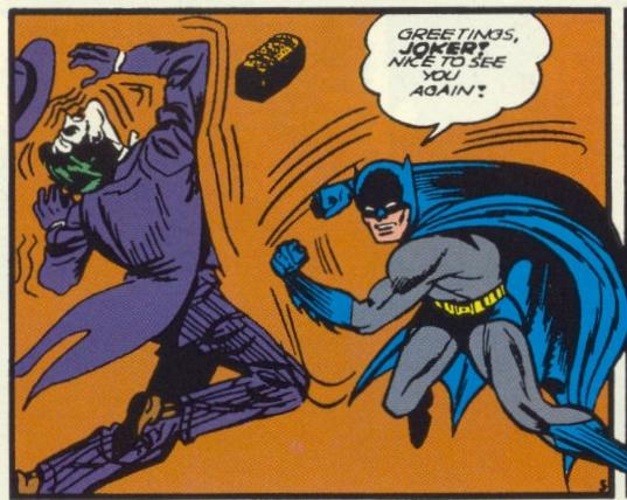PREVIOUS: “A Joker’s Dozen, Part 5“
One of the touchstones of The Joker’s interpretation in comics is the first dozen stories featuring the Joker that follow his introduction as a cold blooded killer and his transformation into a clever prankster that would bedevil Batman over the years without falling prey to the morality police. There are a dozen stories that make up this initial introduction, so 6 parts to go after this.
The Story/Comic Book: “The Riddle of the Missing Card” from BATMAN #5
The Return: The Joker is washed out of the sewers out to sea and found by a group of smugglers.
The Plot: The Joker is running a gambling ship in international waters and robbing the wealthy gamblers of their jewels.
Body Count: Two, by gunshot, although neither by the Joker’s hand.
Joker’s Running Body Count: 13
Other Mayhem: Bruce Wayne is tossed overboard and shot at, Robin is knocked unconscious and held hostage, the Joker causes the Batmobile to go over a cliff, various fights, the Joker sets fire to the ship hoping to catch Batman and Robin and whomever else in the conflagration, a lighthouse keeper is assaulted, and the Joker and Batman and Robin battle at the top of a lighthouse with Batman clinging to an edge.
The Outthink: A tossed deck of cards and an overturned table catches the criminals by surprise.
The Comeuppance: Robin sends the Joker falling off the top of the lighthouse into the sea.
Earlier we’ve seen the clown and the ghoul from the original Joker stories. The latest story plays up the playing card theme for the first extended time with the Joker. And also strikes Batman a personal blow. Ready, then buckle up there’s a lot of events packed into 13 pages.
The story wastes no time into resolving the fate of The Joker from when we last saw him. He was washed out to the ocean and rescued from drowning by a trio of smugglers, Diamond Jack, Queenie, and Clubsy. And in recognition of the difficulties of smuggling in a time of war, they throw in together to form a new venture, a gambling boat in international waters with the added bonus of pumping the guests for information for later burglaries.
We’re given the first hint of the Joker being inspired by themes in this story as he quickly dubs his confederates the King of Clubs, the black Queen of Spades, and the Jack of Diamonds. Almost a complete hand.
Bruce Wayne also gets an extended spotlight. After nicking himself on the chin shaving, a detail that will be relevant later, he goes on the cruise, dances with Queenie (who finds him charming), and quickly discovers the Joker in disguise (as he frequently is in those days) is running things. Of course, he’s discovered, thrown overboard, and shot at. After faking drowning, it’s pretty much a running battle for the rest of the story.
After swimming ashore, Batman and Robin meet the ship back at the docks and a fight ensues. The Joker speeds off in a car, with Batman fast in pursuit in the Batmobile and Robin fighting with the thugs on the ship. Things turn out badly though as Robin is captured and the Joker stops suddenly and causes the Batmobile to go over a cliff to avoid a dangerous crash. Likely one of the first times that one of Batman’s vehicles was destroyed.
The Joker then returns to the ship and is going to deal with Robin until he learns that Batman is still alive. Then, of course, a soon to be typical Joker offer, Robin’s life based on the outcome of a game of cards. Of course, The Joker can’t resist his patented “I hold a the winning card, a Joker” schtick, but Batman, already catching on to how the Joker operates, answers him with a deck of cards in his face. And a table in the face of a henchman. The Joker beats a hasty retreat, and sets fire to the ship in the process, while Batman deals with the thugs.
In the confusion, Diamond Jack draws a bead on Batman’s back, but Queenie intervenes and ultimately shoots Jack herself, saving Batman. Before she can really explain herself, she’s shot in the back by the dying Jack, confesses that she knows Batman is Bruce Wayne, based on the shaving nick, and that she loves him and then dies in his arms after a last kiss.
After that bit of melodrama, Batman and Robin race after Joker in a speedboat. There ends up being a fight at the top of a lighthouse, Batman ends up clutching the ledge with the Joker hovering over, and Robin’s intervention sends Joker toppling into the sea. It’s a sequence that’s a possible influence on the bell tower climax of Tim Burton’s BATMAN (1989). All that’s left is for Batman to explain the riddle of the missing card to Robin. The Joker overlooked the suit of hearts.
There are lots of ideas in this story. Maybe too many to allow any of them to be developed fully. The Joker’s plot, Queenie’s subplot, and the fight scenes all compete for space. The result is a story with many small panels in order to fit it all in. They’re well drawn small panels, but there’s a cramped feeling to the story. Really, there’s enough story here to justify a six issue arc, which really sums up the Golden Age.
Still it’s a strong story. By this time Finger, Kane, and Robinson were well on their way to establishing the Joker as Batman’s arch nemesis. But, there was still something missing. The Joker’s plots lacked panache. Luckily, Bill Finger was about to have a breakthrough in that regard that would define the Joker to the present day. – Robert Reineke

